小升初英语讲解介词:时间地点.doc
- 格式:doc
- 大小:48.05 KB
- 文档页数:3
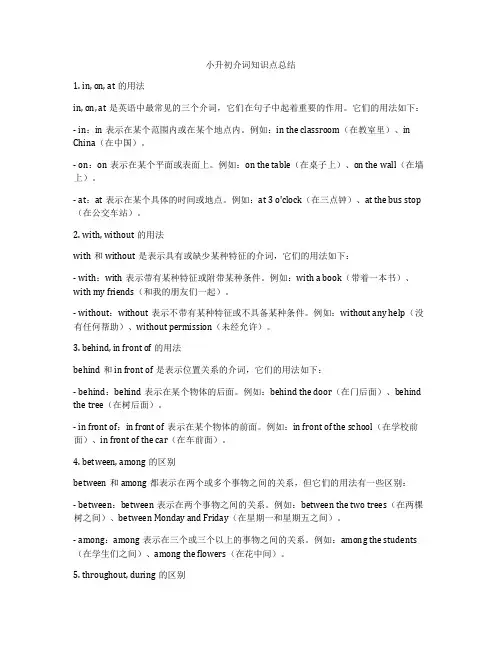
小升初介词知识点总结1. in, on, at的用法in, on, at是英语中最常见的三个介词,它们在句子中起着重要的作用。
它们的用法如下:- in:in表示在某个范围内或在某个地点内。
例如:in the classroom(在教室里)、in China(在中国)。
- on:on表示在某个平面或表面上。
例如:on the table(在桌子上)、on the wall(在墙上)。
- at:at表示在某个具体的时间或地点。
例如:at 3 o'clock(在三点钟)、at the bus stop (在公交车站)。
2. with, without的用法with和without是表示具有或缺少某种特征的介词,它们的用法如下:- with:with表示带有某种特征或附带某种条件。
例如:with a book(带着一本书)、with my friends(和我的朋友们一起)。
- without:without表示不带有某种特征或不具备某种条件。
例如:without any help(没有任何帮助)、without permission(未经允许)。
3. behind, in front of的用法behind和in front of是表示位置关系的介词,它们的用法如下:- behind:behind表示在某个物体的后面。
例如:behind the door(在门后面)、behind the tree(在树后面)。
- in front of:in front of表示在某个物体的前面。
例如:in front of the school(在学校前面)、in front of the car(在车前面)。
4. between, among的区别between和among都表示在两个或多个事物之间的关系,但它们的用法有一些区别:- between:between表示在两个事物之间的关系。
例如:between the two trees(在两棵树之间)、between Monday and Friday(在星期一和星期五之间)。
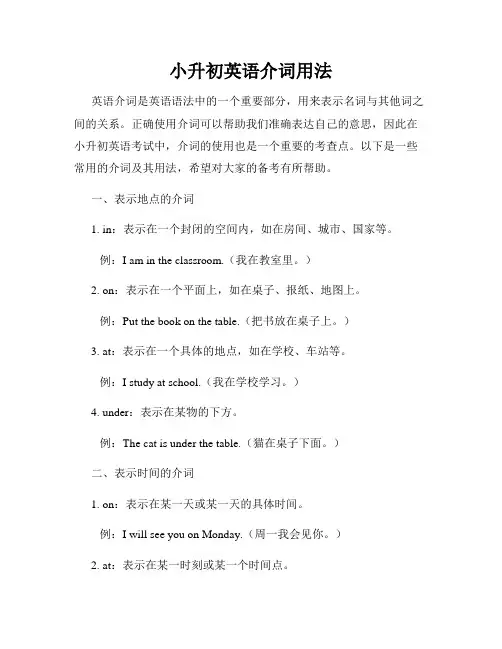
小升初英语介词用法英语介词是英语语法中的一个重要部分,用来表示名词与其他词之间的关系。
正确使用介词可以帮助我们准确表达自己的意思,因此在小升初英语考试中,介词的使用也是一个重要的考查点。
以下是一些常用的介词及其用法,希望对大家的备考有所帮助。
一、表示地点的介词1. in:表示在一个封闭的空间内,如在房间、城市、国家等。
例:I am in the classroom.(我在教室里。
)2. on:表示在一个平面上,如在桌子、报纸、地图上。
例:Put the book on the table.(把书放在桌子上。
)3. at:表示在一个具体的地点,如在学校、车站等。
例:I study at school.(我在学校学习。
)4. under:表示在某物的下方。
例:The cat is under the table.(猫在桌子下面。
)二、表示时间的介词1. on:表示在某一天或某一天的具体时间。
例:I will see you on Monday.(周一我会见你。
)2. at:表示在某一时刻或某一个时间点。
例:The party starts at 8 o'clock.(派对从8点开始。
)3. in:表示在某一段时间内。
例:I will go on vacation in July.(我七月份去度假。
)4. for:表示一段持续的时间。
例:I have been studying English for five years.(我已经学习英语五年了。
)三、表示方式的介词1. by:表示通过某种方式或方法。
例:I go to school by bus.(我乘公交车去学校。
)2. with:表示使用某种工具或伴随的状态。
例:He writes with a pen.(他用钢笔写字。
)四、表示原因的介词1. because of:表示因为某个原因。
例:I am happy because of your help.(因为你的帮助,我很开心。
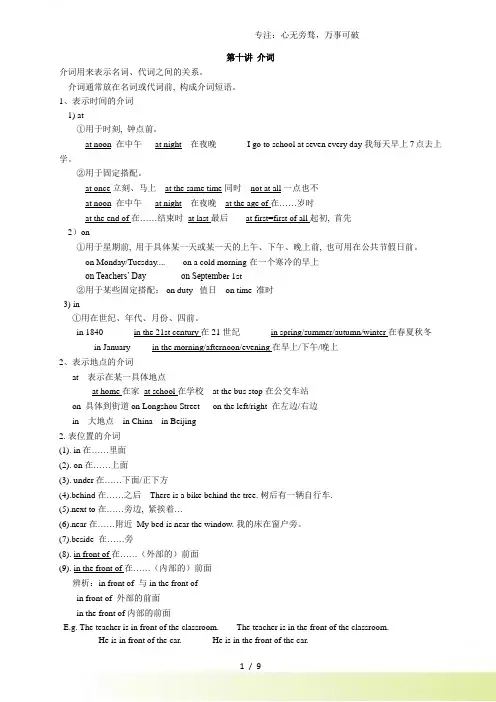
第十讲介词介词用来表示名词、代词之间的关系。
介词通常放在名词或代词前, 构成介词短语。
1、表示时间的介词1) at①用于时刻, 钟点前。
at noon 在中午at night 在夜晚I go to school at seven every day 我每天早上7点去上学。
②用于固定搭配。
at once 立刻、马上at the same time 同时 not at all 一点也不at noon 在中午at night 在夜晚at the age of在……岁时at the end of在……结束时at last最后at first=first of all起初, 首先2)on①用于星期前, 用于具体某一天或某一天的上午、下午、晚上前, 也可用在公共节假日前。
on Monday/Tuesday.... on a cold morning在一个寒冷的早上on Teachers’ Day on Septembe r 1st②用于某些固定搭配: on duty 值日 on time 准时3) in①用在世纪、年代、月份、四前。
in 1840 in the 21st century在21世纪in spring/summer/autumn/winter在春夏秋冬in January in the morning/afternoon/evening在早上/下午/晚上2、表示地点的介词at 表示在某一具体地点at home在家at school在学校at the bus stop在公交车站on 具体到街道on Longshou Street on the left/right 在左边/右边in 大地点in China in Beijing2.表位置的介词(1). in在……里面(2). on在……上面(3). under在……下面/正下方(4).behind在……之后There is a bike behind the tree. 树后有一辆自行车.(5).next to在……旁边, 紧挨着…(6).near在……附近My bed is near the window. 我的床在窗户旁。
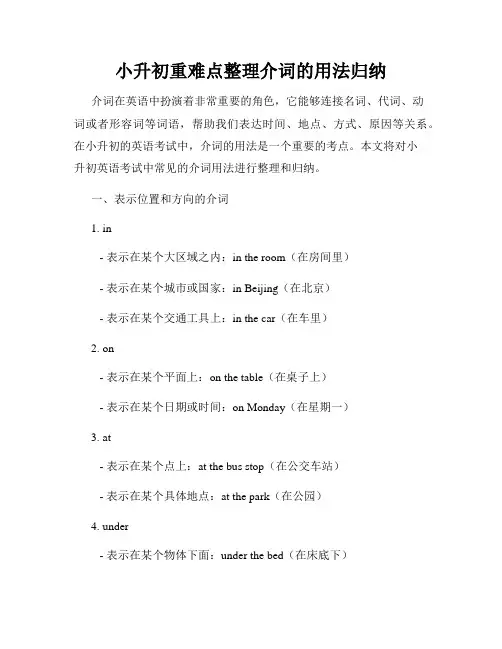
小升初重难点整理介词的用法归纳介词在英语中扮演着非常重要的角色,它能够连接名词、代词、动词或者形容词等词语,帮助我们表达时间、地点、方式、原因等关系。
在小升初的英语考试中,介词的用法是一个重要的考点。
本文将对小升初英语考试中常见的介词用法进行整理和归纳。
一、表示位置和方向的介词1. in- 表示在某个大区域之内:in the room(在房间里)- 表示在某个城市或国家:in Beijing(在北京)- 表示在某个交通工具上:in the car(在车里)2. on- 表示在某个平面上:on the table(在桌子上)- 表示在某个日期或时间:on Monday(在星期一)3. at- 表示在某个点上:at the bus stop(在公交车站)- 表示在某个具体地点:at the park(在公园)4. under- 表示在某个物体下面:under the bed(在床底下)5. behind- 表示在某个物体后面:behind the tree(在树后面)6. next to- 表示在某个物体旁边:next to the library(在图书馆旁边)7. between- 表示在两个物体之间:between the two buildings(在两个建筑物之间)二、表示时间的介词1. in- 表示在某个年、季度、月等的时间段内:in 2022(在2022年) - 表示在某个时间上午或下午:in the morning(在早上)2. on- 表示在某个具体的日期:on June 1st(在6月1日)- 表示在某个星期几:on Sunday(在星期天)3. at- 表示在某个具体的时间点:at 9 o'clock(在9点钟)三、表示原因的介词1. because of- 表示因为某个原因:I couldn't go to the party because of the rain.(因为下雨,我不能去参加聚会)2. due to- 表示由于某个原因:The delay of the flight was due to the bad weather.(航班延误是由于天气恶劣)四、表示方式的介词1. by- 表示通过某种方式:by bus(乘坐公交车)- 表示凭借某种手段:by using a calculator(通过使用计算器)2. with- 表示使用某种工具或方式:write with a pen(用钢笔写)五、表示比较和区别的介词1. like- 表示像某人或某物:She looks like her mother.(她长得像她妈妈) - 表示和...相似:He plays basketball like a professional.(他打篮球像个职业球员)2. unlike- 表示和...不同:Unlike his brother, he doesn't like sports.(和他哥哥不同,他不喜欢运动)六、表示目的的介词1. for- 表示为了某个目的:I bought a gift for my friend.(我给朋友买了一份礼物)2. to- 表示朝着某个目的地或目标:I am going to school.(我正要去学校)总结:介词在英语中的用法是一个重要的语法考点,对于小升初的考生来说尤为关键。
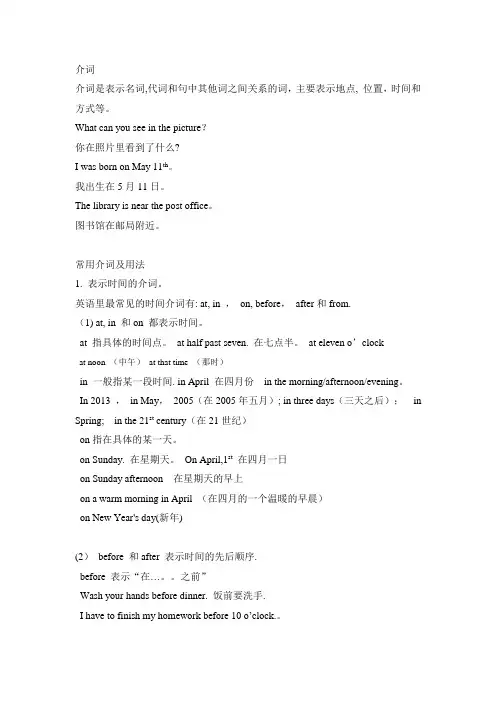
介词介词是表示名词,代词和句中其他词之间关系的词,主要表示地点, 位置,时间和方式等。
What can you see in the picture?你在照片里看到了什么?I was born on May 11th。
我出生在5月11日。
The library is near the post office。
图书馆在邮局附近。
常用介词及用法1. 表示时间的介词。
英语里最常见的时间介词有: at, in ,on, before,after和from.(1) at, in 和on 都表示时间。
at 指具体的时间点。
at half past seven. 在七点半。
at eleven o’clockat noon (中午)at that time (那时)in 一般指某一段时间. in April 在四月份in the morning/afternoon/evening。
In 2013 ,in May,2005(在2005年五月); in three days(三天之后);in Spring; in the 21st century(在21世纪)on指在具体的某一天。
on Sunday. 在星期天。
On April,1st在四月一日on Sunday afternoon 在星期天的早上on a warm morning in April (在四月的一个温暖的早晨)on New Year's day(新年)(2)before 和after 表示时间的先后顺序.before 表示“在…。
之前”Wash your hands before dinner. 饭前要洗手.I have to finish my homework before 10 o’clock.。
我不得不在十点之前做完作业。
after 表示“在….之后”,They often play football after school.他们放学后经常踢足球.My father often watches TV after dinner。
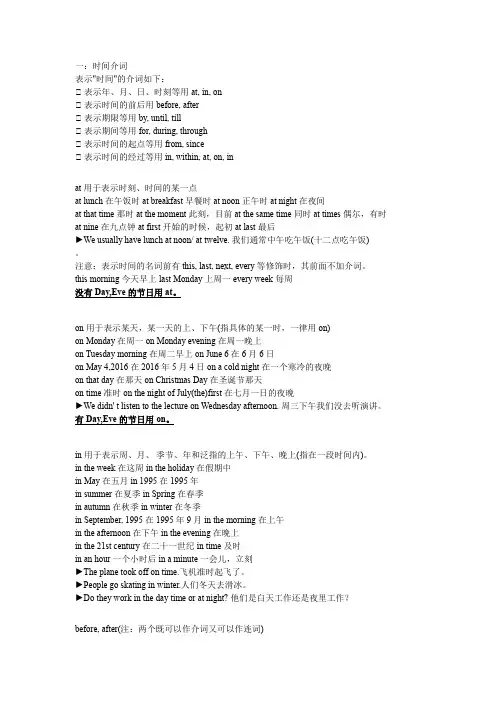
一:时间介词表示"时间"的介词如下:①表示年、月、日、时刻等用at, in, on①表示时间的前后用before, after①表示期限等用by, until, till①表示期间等用for, during, through①表示时间的起点等用from, since①表示时间的经过等用in, within, at, on, inat用于表示时刻、时间的某一点at lunch在午饭时at breakfast早餐时at noon正午时at night在夜间at that time那时at the moment此刻,目前at the same time同时at times偶尔,有时at nine在九点钟at first开始的时候,起初at last最后►We usually have lunch at noon/ at twelve.我们通常中午吃午饭(十二点吃午饭)。
注意:表示时间的名词前有this, last, next, every等修饰时,其前面不加介词。
this morning今天早上last Monday上周一every week每周没有Day,Eve的节日用at。
on用于表示某天,某一天的上、下午(指具体的某一时,一律用on)on Monday在周一on Monday evening在周一晚上on Tuesday morning在周二早上on June 6在6月6日on May 4,2016在2016年5月4日on a cold night在一个寒冷的夜晚on that day在那天on Christmas Day在圣诞节那天on time准时on the night of July(the)first在七月一日的夜晚►We didn' t listen to the lecture on Wednesday afternoon.周三下午我们没去听演讲。
有Day,Eve的节日用on。

介词十时间十地点的用法一、介词简介介词是英语中用于表示时间或地点的词,常见的有at、in、on 等。
它们在句子中起到连接作用,将名词、代词等与句子中的其他部分连接起来。
二、时间介词用法1. at表示时间的一点,用于表示具体时刻,如at 7 o'clock。
2. in表示在某个时间段内或某个较长的时间段内,如in the morning、in a week。
3. on表示特定的某一天或某一天的某个时间,如on Monday、on Saturday afternoon。
三、地点介词用法1. at表示具体地点或场所,如at the bus stop。
2. in表示在某个空间内或某个范围中,如in the classroom。
3. on表示在某个表面上或与某个表面接触的物体上,如on the desk。
四、时间地点组合用法时间与地点的用法通常是用于表达某件事情发生的具体时间和地点。
以下是几种常见的用法:1. 在某年某月某日(某年/月/日)在某地,例如:I met him in New York City on July 4th, 2023. (我在2023年7月4日在新泽西州纽约市遇到了他。
)2. 在某年某月某日几点钟在某地,例如:He arrived at 9o'clock in the morning in Beijing. (他上午9点钟到达北京。
)3. 在某段时间内某地发生某事,例如:The accident happened on the road between London and Edinburgh a few years ago.(几年前,事故发生在伦敦和爱丁堡之间的路上。
)4. 在某个季节或时段在某地,例如:I often go for a walk in the park in spring. (我经常在春天去公园散步。
)需要注意的是,在使用介词表达时间和地点时,要遵循语法规则和语境,避免使用不当的介词导致表达错误。
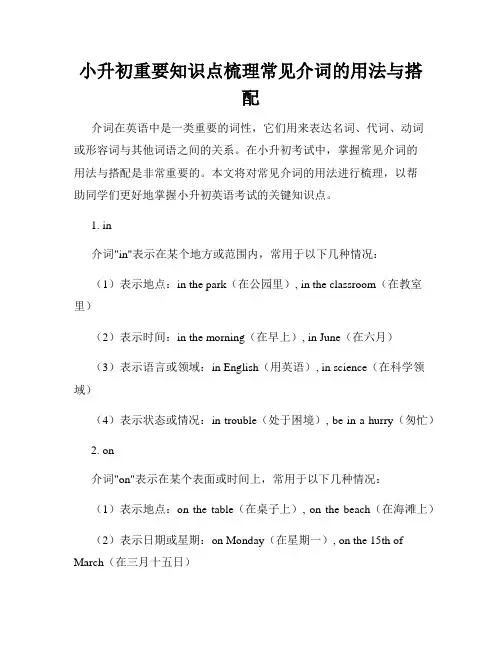
小升初重要知识点梳理常见介词的用法与搭配介词在英语中是一类重要的词性,它们用来表达名词、代词、动词或形容词与其他词语之间的关系。
在小升初考试中,掌握常见介词的用法与搭配是非常重要的。
本文将对常见介词的用法进行梳理,以帮助同学们更好地掌握小升初英语考试的关键知识点。
1. in介词"in"表示在某个地方或范围内,常用于以下几种情况:(1)表示地点:in the park(在公园里), in the classroom(在教室里)(2)表示时间:in the morning(在早上), in June(在六月)(3)表示语言或领域:in English(用英语), in science(在科学领域)(4)表示状态或情况:in trouble(处于困境), be in a hurry(匆忙)2. on介词"on"表示在某个表面或时间上,常用于以下几种情况:(1)表示地点:on the table(在桌子上), on the beach(在海滩上)(2)表示日期或星期:on Monday(在星期一), on the 15th of March(在三月十五日)(3)表示媒介或交通工具:on the radio(通过收音机), on the bus (在公交车上)3. at介词"at"表示在某个具体的地点或时间上,常用于以下几种情况:(1)表示地点:at school(在学校), at the park(在公园)(2)表示具体的时间点:at 2 o'clock(在两点钟), at Christmas (在圣诞节)(3)表示瞬间动作:laugh at(嘲笑), shout at(对...喊叫)4. by介词"by"表示通过某种方式或是靠近某人或某物,常用于以下几种情况:(1)表示方式或方法:go to school by bus(乘公交车去学校), send a message by email(通过电子邮件发送消息)(2)表示靠近:stand by the window(站在窗户边)(3)表示时间或截止日期:by next week(在下周之前), finish the project by Monday(在星期一之前完成项目)5. for介词"for"表示表示目的、理由或是接受某种东西,常用于以下几种情况:(1)表示目的或理由:study for the test(为了考试而学习), apologize for the mistake(为错误道歉)(2)表示接受:buy a gift for my mother(给我妈妈买礼物)6. with介词"with"表示伴随、具有或使用某物,常用于以下几种情况:(1)表示伴随:go to the park with my friends(和我的朋友一起去公园)(2)表示具有:a girl with blue eyes(一位拥有蓝眼睛的女孩)(3)表示使用:write with a pen(用钢笔写)7. to介词"to"表示朝向、目标或是接受,常用于以下几种情况:(1)表示朝向:go to school(去学校), run to the park(跑向公园)(2)表示目标:give the book to me(把书给我)(3)表示接受:send a letter to my friend(给我的朋友寄信)8. from介词"from"表示出发点、来源或是离开某地,常用于以下几种情况:(1)表示出发点:come from Beijing(来自北京), start from home (从家出发)(2)表示来源:receive a gift from my friend(从我的朋友那里收到礼物)(3)表示离开:run from danger(逃离危险)以上是小升初英语中常见介词的用法与搭配。
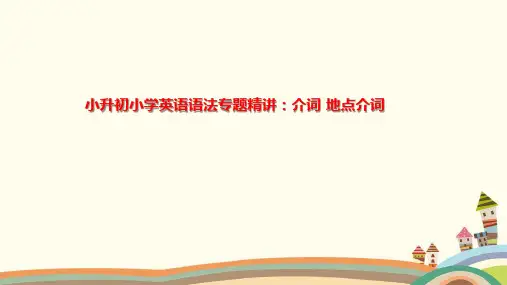
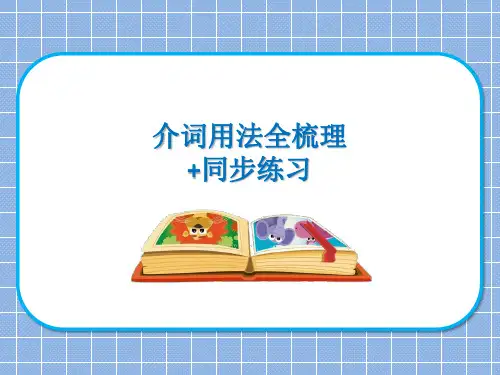
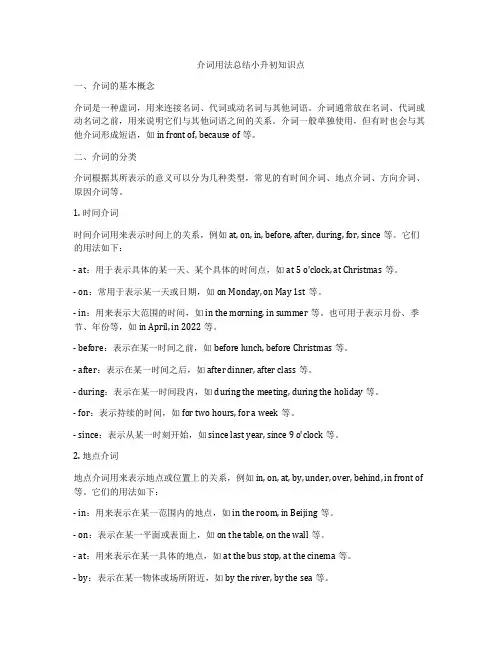
介词用法总结小升初知识点一、介词的基本概念介词是一种虚词,用来连接名词、代词或动名词与其他词语。
介词通常放在名词、代词或动名词之前,用来说明它们与其他词语之间的关系。
介词一般单独使用,但有时也会与其他介词形成短语,如in front of, because of等。
二、介词的分类介词根据其所表示的意义可以分为几种类型,常见的有时间介词、地点介词、方向介词、原因介词等。
1. 时间介词时间介词用来表示时间上的关系,例如at, on, in, before, after, during, for, since等。
它们的用法如下:- at:用于表示具体的某一天、某个具体的时间点,如at 5 o'clock, at Christmas等。
- on:常用于表示某一天或日期,如on Monday, on May 1st等。
- in:用来表示大范围的时间,如in the morning, in summer等。
也可用于表示月份、季节、年份等,如in April, in 2022等。
- before:表示在某一时间之前,如before lunch, before Christmas等。
- after:表示在某一时间之后,如after dinner, after class等。
- during:表示在某一时间段内,如during the meeting, during the holiday等。
- for:表示持续的时间,如for two hours, for a week等。
- since:表示从某一时刻开始,如since last year, since 9 o'clock等。
2. 地点介词地点介词用来表示地点或位置上的关系,例如in, on, at, by, under, over, behind, in front of 等。
它们的用法如下:- in:用来表示在某一范围内的地点,如in the room, in Beijing等。
第6讲介词一、介词:(表示地点和时间的“在”,有些是固定搭配,和其他动词形成词组,)at, in, on, behind, beside, with , about, for, of, like(表示像的意思时),by, from to…1.时间:(1). 表示在几点:at seven o’clock, at a quarter past fou r, at eleven twenty等。
1) My father usually goes to work ___at_____ (at, in, on) 8:00.2) The party will begin __at____ (at, in, on) 2:00pm.(2). 表示在早晨,下午,晚上:in the morning, in the afternoon, in the evening.1) We never go shopping ____in__ (at, in, on) the evening.2) I get up at 7:30 _______ (at, in, on) the morning.(3). 表示在具体某一天:on Monday, on Saturday, On Children’ s Day, on June 22, 2006,1). Christmas is _____on_____ (at, in, on) December 25th.2) What is the first lesson(课)______on__ (at, in, on) Tuesday?(4) “在星期天的早晨”这一类应用on Sunday morning( A ) 1. The girl usually practices the piano ________ Saturday morning.A. onB. inC. at( B )2 .He left home ___ a cold winter evening.A. atB. onC. in2.表示地点:in 在…里in the desk, in the classroom, in the playground, in London, in China…on 在…上on the sofa, on the Internet, on the table…behind 在…后面behind the tree, behind the door, behind Jimbeside\near /next to在..旁边,在…附近beside the window, near the school.in front of 在…前面in front of the cinema, in front of him,under 在…下面under the bed, under the tree,3.有独立意思的:(1) with①和…一起并列的成分分开使用时用withI went to the garden ____with___Tom.Liu Tao is going to visit his grandpa _with______his parents.②带有......的特征The boy ___with a pair of eyes_____________is David. 那个有着一双大眼睛的是大卫。
小升初介词相关知识点总结一、介词的概念介词是一种虚词,主要用来表示名词或代词与其他词语之间的关系,如时间、地点、原因、目的、方式等,或者在句子中起连接、修饰、修辞和说明等作用。
介词通常位于名词或代词之前,构成介词短语,对名词或代词进行修饰或补充说明。
例如:in the classroom(在教室里)、at 6 o’clock(在六点钟)、for my sister(为了我妹妹)等。
二、介词的用法1. 表示时间关系的介词有:at, in, on, during等。
如:at 7 o’clock(在七点钟)、in January(在一月份)、on Sunday(在星期日)、during the summer(在夏天)。
2. 表示地点关系的介词有:in, on, at, above, below, behind, in front of, near, next to, between等。
如:in the classroom(在教室里)、on the table(在桌子上)、at the bus stop(在公交车站)、above the sky(在天空之上)、below the ground(在地下)、behind the door(在门后)、in front of the building(在建筑物前)、near the park(在公园附近)、next to the river(在河边)、between the two trees(在两棵树之间)。
3. 表示原因、目的、方式、比较等关系的介词有:because of, in order to, by, with, for, like, as, than等。
如:because of the rain(因为下雨)、in order to pass the exam(为了通过考试)、by bus(乘坐公交车)、with my mother(和我妈妈一起)、for example(例如)、like a bird(像一只鸟儿)、as big as an elephant(和大象一样大)、faster than a car(比汽车快)。
介词一般置于名词之前。
它常和名词或名词性词语构成介词短语。
一、表达时间旳介词注意:不用介词表达旳词组:this year; this morning; last night; last summer; next Sunday;yesterday; tomorrow如:Did you do your homework last night?I am going to Beijing next Sunday.What are you going to do this afternoon?三、方位介词三、表达地点位置旳介词1. at+小地方:at home; at school; at the bus stop; at the library;2. in+大地方:in China; in Zhaoqing;四、固定搭配1. listen to---听write to----写; look at-----看;Please listen to me. 请听我讲。
I will write to you later. 我晚点会写信给你旳。
Please look at the picture 让看着这幅图。
2. in +科目:in English: What's this in English? 这用英语怎么说?in black clothes 穿黑色衣服3. for +动词ing: Thank you for helping me. 谢谢你帮我。
for+某人:I'll make a card for my teacher. 我要给老师做张卡片。
for+早午晚餐:It’s time for breakfast. =It’s time to have breakfast.4. about1) 大概:It’s about six o'clock now. 目前大概6点钟了。
2) 有关:We are talking about the news. 我们正在谈论新闻。
1.介词,是小升初复习中既基础又重要的知识点,是一个比较细又容易出错的知识点,通常在“单项选择”、“完形填空”“作文”写作题中考进行考察。
2.时间介词,地点介词,介词搭配是小升初英语介词中,考查的重点。
1. 熟记常见时间介词、地点介词的基本用法。
2. 熟记常考的介词短语搭配。
3. 将介词正确运用在作文、完形填空、选择题中。
1.时间介词in, on, at, during.2.地点介词in ,on, at.3.介词后的动词名词/代词/ving形式。
4.常见介词用法。
介词定义:英语介词(preposition 简写prep.,以下简称介词。
)介词是一种虚词,不能单独作句子成分,只能用在一个名词、代词或相当于名词的结构之前,可以与后面的词一起构成介词短语。
小学阶段常见介词:in,on,with,by,for,at,about,under,of,from, to,during,before, after,beside, behind, below, above, into, over,within,up, down。
介词后+名词/代词/Ving形式。
以下就常考介词进一步分析:1.at 用在某一段时刻。
Eg. at dawn/daybreak 在黎明at six (o’clock)在六点at night在夜晚at 4:30在4点30用at 来表示在……岁时at sixteen/at the age of sixteen :16岁的时候I go to school _______seven every day.A. atB. inC. onD. for答案:A2.on主要用在星期几、具体某一天或某一天的早、中、晚或节日前。
Eg. on Mid-Autumn Day 在中秋节on June 1st 在6 月1 日on Christmas Day 在圣诞节那一天,也可用at Christmason New Year's Day在新年那天I usually stay ______home______Saturday.A .at, on B. at, inC. in, atD. in, on答案:A3.in表示一段时间,用于年、月、四季或泛指的一天的上午、下午、晚上等前。
介词是一种用来表示词与词, 词与句之间的关系的词。
在句中不能单独作句子成分。
介词后面一般有名词代词或相当于名词的其他词类,短语或从句作它的宾语。
介词和它的宾语构成介词词组,在句中作状语,表语,补语或介词宾语。
并且在定语从句“介词+wh om/which”的结构中,不能用that 代替whom/which。
She is a good student from whom we should learn.介词分为时间介词.地点位置方向介词.方式介词.原因介词和其他介词1.表示地点位置的介词1)at ,in, on, to,forat (1)表示在小地方; (2)表示“在……附近,旁边”in (1)表示在大地方; (2)表示“在…范围之内”。
on 表示毗邻,接壤,“在……上面”。
to 表示在……范围外,不强调是否接壤;或“到……”2)above, over, on 在……上above 指在……上方,不强调是否垂直,与 below相对;over指垂直的上方,与under相对,但over与物体有一定的空间,不直接接触。
on表示某物体上面并与之接触。
The bird is flying above my head.There is a bridge over the river.He put his watch on the desk.3)below, under 在……下面under表示在…正下方below表示在……下,不一定在正下方There is a cat under the table.Please write your name below the line.4)in front [frant]of, in the front of在……前面in front of…意思是“在……前面”,指甲物在乙物之前,两者互不包括;其反义词是behind(在……的后面)。
There are some flowers in front of the house.(房子前面有些花卉。
小升初英语总复习精讲精练之介词(一)
Cherry王老师Cherry王老师课堂2016-12-17
【精讲】前段时间,我们一起复习巩固了名词、冠词、代词和数词,今天我们一起来梳
理一下小升初考试的介词部分。
介词的拼写通常很简单,所以小升初考点不会放在介词
拼写这一部分,但是常考的介词相对较多,每一种介词不止一种意思,考点又比较灵
活,同时,还有很多固定搭配短语,这些固定搭配中的介词往往不是它本身的意思或者
没有实际意义,因为这一部分需要同学们平时反复记忆背诵,熟记于心。
表示时间的介词:
1、用 at 的时间短语:
( 1 )用于具体时刻前:at 5 o ’clock, at 8 o ’clock
( 2 )用于三餐时间前:at lunch time , at dinner time
( 3 )用于年龄之前(在某人几岁的时候):at ten , at the age of ten
( 4 )其他时间: at noon , at night , at that time , at that moment
2、用 on 的时间短语:
( 1 )用于星期前: on Monday , on Friday , on weekends
(2 )用于具体日期前:on July 26 th, on May 1st
( 3 )用于星期的上午、下午、晚上前:on the morning of Thursday , on the evening
of Sunday
( 4 )用于具体日期的上午、下午、晚上前:on the morning of January 3 rd, on the afternoon of August 8th
(5 )用于节日前: on Children ’ s Day, on Teachers ’Day
3、用 in 的时间短语:
( 1 )用于上午、下午、晚上前:in the morning,in the afternoon,in the evening
(2 )用于月份前: in October , in April
( 3 )用于年份前:in 1986 , in 2009
( 4 )用于季节前:in spring , in autumn
表示地点的介词:
1、用 at 的地点短语:
( 1 )用于建筑物等较小范围的地点前:at school , at home
( 2 )用于车站、机场前:at the bus stop , at the airport
2、用 in 的地点短语:
(1 )用于国家前: in China , in America
(2 )用于城市前: in Shanghai , in our city
3、 on , above , over , below , under 的用法
( 1 ) on :在...... 上面,有接触面
The pencils are on the book.铅笔在书上。
( 2 ) above: 在 ...... 上方,没有接触面,不强调垂直关系
There are some birds flying above the tree.
一些小鸟从树上飞过。
( 3 ) over: 在 ...... 正上方,不接触,强调垂直
There is a bridge over he river.河上有一座桥。
( 4 ) below:在......下方,不接触,不强调垂直
There is a street over my window.
我窗户下面是一条街道。
(5 ) under: 在 ...... 下方,不接触,强调垂直
Your baseball is under the desk.
你的棒球在书桌下面。
4、 at, by , beside , near , next to
(1 ) at, by, beside: 均表示在旁边
She sat down at the table.
她坐在桌子旁边。
I will be here by your side.
我会在你身边。
He put his umbrella beside the door.
他把雨伞靠着门放。
(2 ) Near: 表示在 ...... 附近
Our school is near my home.
我们学校在我家附近。
(3 ) next to :表示紧靠
The park is next to the library.
这个公园紧靠图书馆。
5、 between , among
(1 ) between: 表示在两者之间
Mary sits between Lucy and Linda.
玛丽坐在露西和琳达之间。
( 2 ) among: 表示在三者或以上的中间
That boy sleeps among his toys.
这个小男孩睡在他的玩具中间。
6、 in front of,in the front of
( 1 ) in front of:表示在某一空间外部的前面
There is a big tree in front of our school building.
教学楼前面有一棵大树。
( 2 ) in the front of:表示在某一空间内部的前面
The teacher is standing in the front of the classroom.老师正站在教室前面。
7、 across , through
(1 ) across :在表面穿过
You must be very careful when you go across the road.当你过马路时一定要小心。
( 2 ) through: 在内部穿过
They went through the forest. 他们穿过树林。
表示手段和材料的介词:
1、 by 表示用某种方式,多用于交通:
2、 with表示用某种工具:with a pen
3、 in 表示用某语言或穿某种颜色的衣服:
by car , by bus
, with a ball
in English, in Chinese; in red, in blue
【精练】
选择正确的介词填空
1、 My birthday is ______ (on, in) October 8th .
2、 She will visit her aunt ______ (in, on) summer.
3、 I usually go to work ______ (at, in) half past seven.
4、 Let ’ s go to the park _______(in, on) Sunday afternoon.
5、 What do you often do _______(at, on) weekends ?
6、 Summer comes _______ (before, after) spring.
7、 He began to learn English _______ (at, in) the age of 6.
8、 I was born ______ (on, in) 1990.
9、 We give some flowers to our teachers _______ (at, on) Teachers
’Day.
10、 Let ’ s go to the zoo______ (on,by) car.
11、 Please say it ______(with, in) English!
12 Who is the lady ______(in.of) red ?
【精练答案】
1--6 on, in, at,on, at, after
7--12 at,in,on,by,in,in。